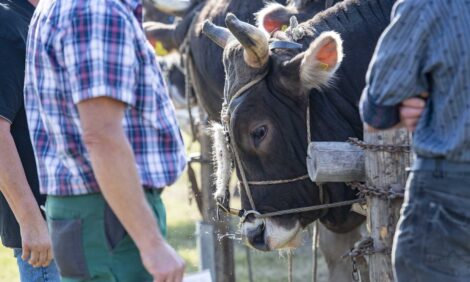



Greenhouse Gases and Environmental Impacts of the Livestock Industry
The livestock sector is not only contributing to global warming, it is suffering from it as well, writes Chris Harris, Senior Editor, TheCattleSite.Changes in the weather have a severe effect on grazing land and livestock production systems Pierre Gerber, Livestock Policy Officer Animal Production and Health Division at the FAO, told the recent World Meat Congress in Cape Town, South Africa.
He said it is a great challenge for food security and the security of the public's health and biodiversity and it is also a challenge for the livestock industry.
Dr Gerber said that at present 3.4 billion hectares around the world is devoted to pasture land - 26 per cent of the total of "emerged lands". While this was being used to a low intensity in the developing nations, the intensity of production was increasing in the Latin American countries.
A large part of this pasture land is too dry or too cold for crop use, and only sparsely inhabited.
While the grazing area is not increasing on a global scale, in tropical Latin America there is rapid expansion of pastures, which is encroaching into valuable ecosystems, with 0.3 to 0.4 per cent of forest lost to pasture annually, Dr Gerber said.
Ranching is a primary reason for this deforestation. About 20 per cent of the world's pastures and rangeland have been degraded to some extent - maybe as much as 73 per cent in dry areas.
This growing intensity of production is reflected in the fact that global production of meat is expected to more than double form 229 million tonnes in 1999/2001 to 465 million tonnes by 2050 and milk production in the same period will go up from 580 million tonnes to 1,043 million tonnes.
The bulk of this growth will be in the developing countries - Brazil, China, India and Russia in particular.
At the same time the global demand for livestock products is also expected to double.
The total area dedicated to feed crop production is 471 million hectares, equivalent to 33 per cent of the total arable land and most of this is in the developed countries.
Recent reports from the UN and other organisations show that land use changes that have followed deforestation contribute 18.3 per cent to total greenhouse gas emissions, while agriculture accounts for 13.5 per cent (six per cent of which is agricultural soils and 5.1 per cent is livestock and manure) and the transportation sector accounts for 13.5 per cent with 10 per cent down to road transport.
Dr Gerber said that estimates of greenhouse gas emissions for the livestock sector are substantial when the different forms of emissions throughout the livestock commodity chain are taken into account.
Emissions come from feed production, such as chemical fertiliser production, deforestation for pasture and feed crops, cultivation of feed crops, feed transport and soil organic matter losses in pastures and feed crops. The emissions also come from animal production, such as enteric fermentation and methane and nitrous oxide emissions from manure and as a result of the transportation of animal products.
Dr Gerber said that livestock production contributes about nine per cent of the total carbon dioxide emissions produced by human activity, but 37 per cent of methane and 65 per cent of nitrous oxide emissions.
In total there are 7.1 billion tonnes of CO2 produced through feed and livestock production in the world and he said that CO2 releases resulting from fossil fuel consumption used for the production of feed grains (tractors, fertiliser production, drying, milling and transporting) and feed oil crops also need to be attributed to livestock.
The same applies to the processing and transport of animal products.
Dr Gerber told the conference that there is a similar impact from the livestock sector on water usage throughout the world.
The livestock sector accounts for about eight per cent of the total water used and most of this is used on feed crops and irrigation of pasture land.
There are also consequences for the water supply through the pollution of water by manure and pathogens and contaminants from livestock and freed production and there are consequences for the erosion of the soil through grazing animals and intensive rearing of animals.
The growing intensity of livestock production is changing the biodiversity of the world and is having an effect of different ecosystems.
"Climate change is a big problem, but there are other issues as well," Dr Gerber said.
He said the industry and governments need to control land use and control the carbon and nitrogen in cultivated soil. He said it is necessary to manage livestock production better for productivity gain and also for manure management.
He added that given the projected expansion of the livestock sector, major corrective measures need to be taken to address the environmental impact of livestock production, which will otherwise worsen dramatically.
Growing economies and populations, together with the increasing scarcity of environmental resources and rising environmental problems, are more and more demanding enhanced environmental services, such as clean air and water, and recreation areas.
He said that while there will be an increasing intensification in livestock production, the challenge will be to make the process environmentally acceptable.
With extensive land-based production the decision makers will have to ensure that it includes environmental parameters particularly in vulnerable areas.
Dr Gerber added that policy makers need to provide a framework for landscape maintenance, biodiversity protection, clean water and eventually carbon sequestration from extensive grazing systems, in addition to that for the production of conventional livestock commodities.
"Policy decisions have to take into account environmental and health aspects of livestock production," he said.
"And the FAO is endeavouring to raise awareness of these problems."
A strong political will and urgency, together with the identification of potential contributors and beneficiaries, are required to initiate action and investment, Dr Gerber concluded.


